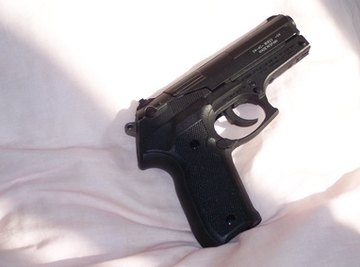
How fast a bullet is traveling when it leaves the end of a gun's barrel, called the muzzle velocity, is of great interest to both those who work in the field of ballistics and physics students looking to cover a few key concepts in one, well, shot.
If the mass m and muzzle velocity v of a bullet are known, its kinetic energy and momentum can be determined from the relationships Ek = (1/2)mv2 and momentum p = mv. This information in turn can reveal a lot about the sort of biological and other effects that can result from the single discharge of a firearm.
Muzzle Velocity Equation
If you know the acceleration of the bullet, you can determine muzzle velocity from the kinematics equation
where v0 = initial velocity = 0, x = distance traveled inside the gun barrel, and v = muzzle velocity.
If you aren't given the value of the acceleration but instead know the firing pressure inside the barrel, a muzzle velocity formula can be derived from the relationships between net force F (mass times acceleration), area A, mass m, pressure P (force divided by area) and acceleration a (force divided by mass).
Because P = F/A, F = ma, and the area A of the cross-section of a cylinder (which a gun muzzle can be assumed to be) is πr2 (r being the radius of the muzzle), a can be expressed in terms of these other quantities:
Alternatively you could get a rough estimate of the bullet's velocity by measuring the distance from the muzzle to a target and dividing this by the time it takes the bullet to reach the target, though there will be some loss due to air resistance. The best way to determine muzzle velocity is by using a chronograph.
Kinematic Equations for Projectile Motion
The standard equations of motion govern everything that moves, from bullets to butterflies. Here we specifically present the form these equations take in the case of projectile motion.
All projectile-motion problems are free-fall problems, because after an initial velocity is given to the projectile at time t = 0 of the problem, the only force acting on the projectile is gravity. So no matter how fast a bullet is fired, it is falling toward Earth just as quickly as if it had been simply dropped from your hand. This counter-intuitive property of motion rears its head repeatedly in projectile-motion problems.
Note that these equations are independent of mass and do not take into account air resistance, a common qualification in simple physics calculations. x and y are horizontal and vertical displacement in meters (m), t is time in seconds (s), a is acceleration in m/s2, and g = the acceleration due to gravity on Earth, 9.81 m/s2.
By using these equations, you can determine the path of a fired bullet and even correct for drop due to gravity when aiming at a distant target.
Selected Muzzle Velocities
Typical handguns have muzzle velocities in the range of 1,000 ft/s, which means that such a bullet would travel a mile in a little over five seconds if it hit nothing or did not fall to the ground by that point. Some police firearms are equipped to discharge bullets at over 1,500 ft/s.
- To convert from ft/s to m/s, divide by 3.28.
Muzzle Velocity Calculator
See the Resources for an online tool that allows for the input of very granular information about specific firearms and bullets to achieve estimates of muzzle velocity and other data related to ballistics.
References
Resources
About the Author
Kevin Beck holds a bachelor's degree in physics with minors in math and chemistry from the University of Vermont. Formerly with ScienceBlogs.com and the editor of "Run Strong," he has written for Runner's World, Men's Fitness, Competitor, and a variety of other publications. More about Kevin and links to his professional work can be found at www.kemibe.com.
Photo Credits
a gun image by timur1970 from Fotolia.com
